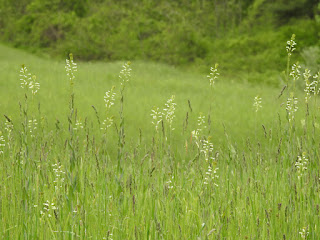Color. We are surrounded by it every day. And it affects us in ways that we don’t even realize. Color evokes emotion, triggers memories, sets a mood, and makes a statement. We respond to color without even knowing it.
 Artists, designers and marketing professionals know this. We use colors to tug at your emotions. We can soothe, excite, and we even make you hungry. Manipulative? Maybe. Effective? Absolutely.
Artists, designers and marketing professionals know this. We use colors to tug at your emotions. We can soothe, excite, and we even make you hungry. Manipulative? Maybe. Effective? Absolutely.
I love green in most of its various forms, but I wonder if lately it has been suffering a bit from overuse. And this worries me.
Green carries with it a lot of responsibility. To “be green” now means to be a good steward of the earth, or at least to try to be. The supermarket and big box stores are full of green these days and when we see green on a package or advertisement, our brain’s tell us that generally, we are looking at something eco-friendly, fresh, natural or healthy.
Historically green has lots of other meanings that we seem to overlooked today. Green has been used to represent envy, money and greed. And ironically, green has been used to represent polar opposites: fertility, renewal, immaturity, illness and health – at the same time.
There are a lot of contradictions here I know, but think about the shades of green out there. They can be bright and vital, or sickly gaunt and leering. They can be deep and rich, or subtle and soft, dull and mute, or jarringly bright.
So much can be done with green, but lately most uses seem to be that middle bright, springy green, similar to the Pantone color of the year.
Today, we are drawn toward freshness, earthiness and eco-friendliness with good reason. And the shades of green chosen seem much more positive these days than when it was used to denote greed and envy.
I think its a good turn of events really, unless by using it we dilute its meaning. What do you think?
 Artists, designers and marketing professionals know this. We use colors to tug at your emotions. We can soothe, excite, and we even make you hungry. Manipulative? Maybe. Effective? Absolutely.
Artists, designers and marketing professionals know this. We use colors to tug at your emotions. We can soothe, excite, and we even make you hungry. Manipulative? Maybe. Effective? Absolutely.As a designer and an artist, I find color irresistible and fascinating.
Pantone named “Greenery 15-03043” the color of the year. It's an energetic yellow based green that feels fresh and new. I love the color that they chose, it's one I gravitate towards in my work fairly often.I love green in most of its various forms, but I wonder if lately it has been suffering a bit from overuse. And this worries me.
Green has become a color with far more meaning than the hue it vibrates.
Green carries with it a lot of responsibility. To “be green” now means to be a good steward of the earth, or at least to try to be. The supermarket and big box stores are full of green these days and when we see green on a package or advertisement, our brain’s tell us that generally, we are looking at something eco-friendly, fresh, natural or healthy.
But is green being used so much that it is beginning to become invisible? Are we over saturating the marketplace with green?
Historically green has lots of other meanings that we seem to overlooked today. Green has been used to represent envy, money and greed. And ironically, green has been used to represent polar opposites: fertility, renewal, immaturity, illness and health – at the same time.
There are a lot of contradictions here I know, but think about the shades of green out there. They can be bright and vital, or sickly gaunt and leering. They can be deep and rich, or subtle and soft, dull and mute, or jarringly bright.
So much can be done with green, but lately most uses seem to be that middle bright, springy green, similar to the Pantone color of the year.
I wonder if people are still seeing and responding to it as much as they would if it wasn't being used as often.
Today, we are drawn toward freshness, earthiness and eco-friendliness with good reason. And the shades of green chosen seem much more positive these days than when it was used to denote greed and envy.
I think its a good turn of events really, unless by using it we dilute its meaning. What do you think?



Comments
Post a Comment